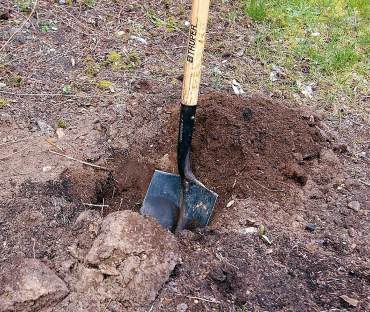 Normally, the best time of the year to plant any plant, including our native plants, is during the dormant season. In Western Washington, that time is generally late October through early February. Fall planted plants have a longer time to take advantage of cool temperatures and moist soils to establish new roots before putting out new spring growth. We all know, however, that the best time for people to put plants in the ground is spring and summer, when the weather lures us outside and the nurseries are brimming with lush and tempting flora.
Normally, the best time of the year to plant any plant, including our native plants, is during the dormant season. In Western Washington, that time is generally late October through early February. Fall planted plants have a longer time to take advantage of cool temperatures and moist soils to establish new roots before putting out new spring growth. We all know, however, that the best time for people to put plants in the ground is spring and summer, when the weather lures us outside and the nurseries are brimming with lush and tempting flora.
Not to fear. We are blessed with a mild and forgiving gardening climate that allows us, when we take care, to successfully transplant most potted plants out of season. Here are some basic tips to ensure the plant that you can’t pass up in June is around and thriving the following summer.
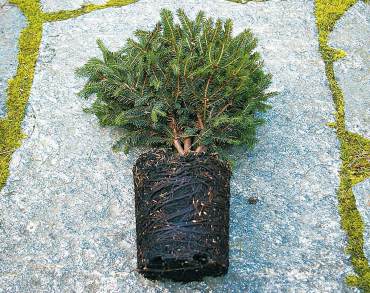 When planting plants out of season, it is important to provide regular water to ensure roots damaged during transplanting can still support the existing plant and any new spring and summer growth. Usually any plant, including natives, whether planted in the preferred dormant season or not, will need regular spring, summer and sometimes fall watering for the first two years to become well established and deeply rooted.
When planting plants out of season, it is important to provide regular water to ensure roots damaged during transplanting can still support the existing plant and any new spring and summer growth. Usually any plant, including natives, whether planted in the preferred dormant season or not, will need regular spring, summer and sometimes fall watering for the first two years to become well established and deeply rooted.
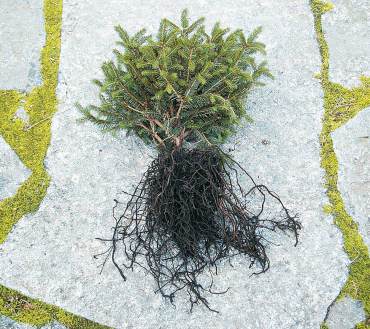 When preparing to plant, always thoroughly water each plant in its pot so that the root ball is completely saturated. This step hydrates the roots before transplanting, helping the plant survive the shock caused by fewer, damaged roots. Thoroughly wetting the potting soil also allows a better interface between the soil from the pot and the soil in the ground. In other words, it helps the plant to take up water from the new soil surrounding it once it’s planted. Sometimes it is necessary, when a plant is particularly root bound, to entirely submerge the plant pot in a large bucket of water for a couple of hours in order to completely soak the root ball.
When preparing to plant, always thoroughly water each plant in its pot so that the root ball is completely saturated. This step hydrates the roots before transplanting, helping the plant survive the shock caused by fewer, damaged roots. Thoroughly wetting the potting soil also allows a better interface between the soil from the pot and the soil in the ground. In other words, it helps the plant to take up water from the new soil surrounding it once it’s planted. Sometimes it is necessary, when a plant is particularly root bound, to entirely submerge the plant pot in a large bucket of water for a couple of hours in order to completely soak the root ball.
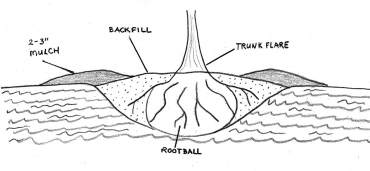 Dig a hole so that the depth of the plant in the ground will be similar to the depth of the potting medium. You don’t want to bury the trunk, or main stems of the plant, any deeper than it was before, lest the plant rot. In fact, planting it just a bit higher than the edges of the planting hole allows for settling over time and for adding a mulch layer. The planting hole should be dug about twice the width of the pot; more if you are planting a woody shrub or tree. Keep in mind that in most soils, plant roots will grow more sideways than down and so that is why the planting hole should be wider than it is deep.
Dig a hole so that the depth of the plant in the ground will be similar to the depth of the potting medium. You don’t want to bury the trunk, or main stems of the plant, any deeper than it was before, lest the plant rot. In fact, planting it just a bit higher than the edges of the planting hole allows for settling over time and for adding a mulch layer. The planting hole should be dug about twice the width of the pot; more if you are planting a woody shrub or tree. Keep in mind that in most soils, plant roots will grow more sideways than down and so that is why the planting hole should be wider than it is deep.
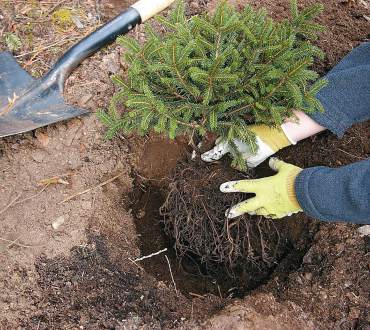 Gently remove the plant from its pot and loosen the roots, untangling them and stretching them out in the planting hole. If there are any large roots that are kinked at an angle of 90 degrees or more, prune them off cleanly at the angle. Redirect circling roots downward into the hole and away from the main trunk or stems.
Gently remove the plant from its pot and loosen the roots, untangling them and stretching them out in the planting hole. If there are any large roots that are kinked at an angle of 90 degrees or more, prune them off cleanly at the angle. Redirect circling roots downward into the hole and away from the main trunk or stems.
Backfill around the plant using soil from the hole, making sure it is loosened and any large rocks are removed. Gently tamp down the soil over the roots with your hands and then water well, taking time to let all the water soak into the new planting hole rather than just running off and away. Depending on the size of the plant, you should apply at least 3 gallons of water to the new plant in order for the soil all around the plant to be evenly moist; more for shrubs and trees. Then check again to make sure that after settling, the plant is at the proper level. If it is not, adjust it and gently pat the soil around the roots again. A 3-inch layer of compost around the base of the plant, but not touching or burying the main plant stems or trunk, is all the fertilizer you will need initially. The roots will spread out into that loose dirt oil and then in time, into the surrounding soil, making a well-anchored and deeply rooted plant that is able to withstand infrequent watering.
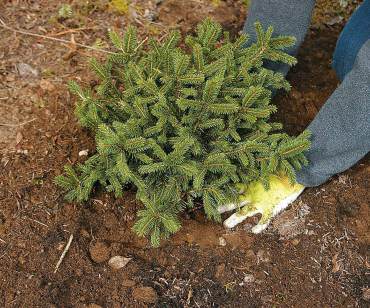 Check the new plant often, especially in hot, dry or windy weather, and make sure the soil is moist by sticking your finger two inches deep; the surface is not a good indicator. Look out for wilting and leaf drop. At least one weekly watering is needed during the first summer, though the plant may need watering daily for awhile after transplanting. This is especially true for plants placed in full sun. And don’t let a summer rain shower fool you! Even if we have some rain, monitor the soil around the plant because in the summer, it takes several hours of constant, heavy precipitation to penetrate the soil. Not to mention that overhanging trees and buildings can block rain and much is lost to evaporation and run-off.
Check the new plant often, especially in hot, dry or windy weather, and make sure the soil is moist by sticking your finger two inches deep; the surface is not a good indicator. Look out for wilting and leaf drop. At least one weekly watering is needed during the first summer, though the plant may need watering daily for awhile after transplanting. This is especially true for plants placed in full sun. And don’t let a summer rain shower fool you! Even if we have some rain, monitor the soil around the plant because in the summer, it takes several hours of constant, heavy precipitation to penetrate the soil. Not to mention that overhanging trees and buildings can block rain and much is lost to evaporation and run-off.
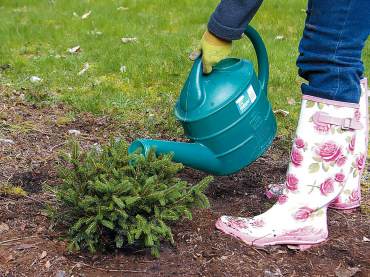 Afraid you can’t keep up with demanding summer watering? Another option to summer transplanting is to place the plant in a larger pot temporarily and wait until the preferred planting time in late fall to put it in its permanent spot. This has several advantages. Transplanting into a larger container of fresh potting soil allows the plant room for its roots to still grow during the summer without fear of it becoming pot-bound. A sun-loving plant in a pot can be placed in a shadier spot temporarily while the plant outgrows transplant shock, increasing its chances of survival. And when watering needs are greatest, placing the pot in a focal area makes it easier to spot wilting, not to mention easier to appreciate your new, must-have plant!
Afraid you can’t keep up with demanding summer watering? Another option to summer transplanting is to place the plant in a larger pot temporarily and wait until the preferred planting time in late fall to put it in its permanent spot. This has several advantages. Transplanting into a larger container of fresh potting soil allows the plant room for its roots to still grow during the summer without fear of it becoming pot-bound. A sun-loving plant in a pot can be placed in a shadier spot temporarily while the plant outgrows transplant shock, increasing its chances of survival. And when watering needs are greatest, placing the pot in a focal area makes it easier to spot wilting, not to mention easier to appreciate your new, must-have plant!
For specific planting instructions for the plant type and species you are purchasing, ask the Certified Professional Horticulturist on staff at your favorite nursery.
































Comments